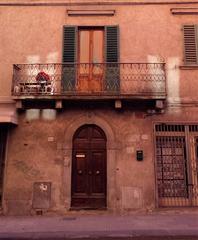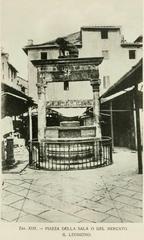Museo Della Musica E Delle Percussioni: Visiting Hours, Tickets, and Travel Guide | Pistoia, Italy
Date: 03/07/2025
Introduction
Nestled in the heart of Pistoia, Tuscany, the Museo della Musica e delle Percussioni offers a captivating exploration of musical heritage, focusing on the evolution, artistry, and global significance of percussion instruments. Founded in 2008 by the Fondazione Luigi Tronci, the museum preserves the legacy of the Tronci family—renowned instrument makers whose innovations shaped both Italian and international music. Housed in the historic Conservatorio San Giovanni Battista on Corso Gramsci, the museum is a must-visit for music lovers, cultural travelers, and anyone intrigued by Tuscany’s rich artistic tradition (fondazioneluigitronci.org, territorio.pistoia.it).
Table of Contents
- Brief History and Cultural Significance
- The Tronci Family Legacy
- Museum Collection and Highlights
- Visiting Hours and Tickets
- Guided Tours and Educational Programs
- Location, Accessibility, and Getting There
- Special Events and Community Engagement
- Nearby Attractions in Pistoia
- Visitor Tips and FAQs
- Plan Your Visit & Stay Connected
- References
Brief History and Cultural Significance
The Museo della Musica e delle Percussioni was established to safeguard and showcase over 250 years of the Tronci family’s contributions to musical instrument craftsmanship. The collection includes over 1,000 instruments from around the world—ranging from historical organs and bells to exotic percussion and modern sound sculptures. Through immersive exhibits and interactive experiences, the museum highlights the cultural and technological evolution of percussion, underscoring Pistoia’s pivotal role in Italy’s musical heritage (visitpistoia.eu).
The Tronci Family Legacy
18th Century Beginnings
The Tronci family began as organ builders in the mid-1700s, crafting exquisite church organs and establishing Pistoia as a center for musical excellence. Their expertise soon expanded to encompass bells, chimes, and a wide range of percussion instruments.
Growth and Innovation
By the 19th and 20th centuries, the Troncis were renowned for their theatrical percussion, collaborating with composers such as Verdi and Puccini. Their innovations in drum tuning and mallet design influenced Italian and international music.
Modern Era
In the 20th century, Luigi Tronci co-founded UFIP (Unione Fabbricanti Italiani Piatti), propelling the family’s cymbals and percussion instruments onto the global stage (discoverpistoia.it).
Museum Collection and Highlights
The museum’s collection is organized thematically:
- Historic Percussion: Rare drums, timpani, cymbals, and mallet instruments crafted by the Tronci family.
- Global Instruments: Djembes, tablas, maracas, and idiophones from Africa, Asia, and the Americas, illustrating percussion’s universal language.
- Mechanical and Experimental: Early music boxes, player pianos, and sound sculptures.
- Tronci Workshop Artifacts: Original blueprints, molds, and tools that shed light on centuries-old craftsmanship.
- Interactive Displays: Playable instruments and hands-on sound laboratories for all ages.
Many instruments remain playable and are featured in live demonstrations, making each visit dynamic and engaging (ViviPistoia.it).
Visiting Hours and Tickets
Opening Hours
- General Schedule: Tuesday to Sunday, 10:00 AM – 6:00 PM (last entry at 5:30 PM).
- Closed: Mondays and select public holidays. Always check the official website for seasonal or event-specific changes.
Tickets
- Standard Admission: €7–€8
- Reduced Rates: €4–€5 for students and seniors
- Children under 12: Free
- Groups & Families: Discounts available; advance reservation recommended
Tickets can be purchased at the museum entrance or online via the official tourism portal.
Guided Tours and Educational Programs
- Guided Tours: Offered in Italian and English; advance booking recommended, especially for groups or English-language tours.
- Workshops: Hands-on experiences for children and adults, including instrument-building and rhythm workshops.
- Live Demonstrations: Musicians perform on rare and antique instruments, bringing history to life.
- School Programs: Tailored activities aligned with educational curricula (Orari di Apertura 24).
Location, Accessibility, and Getting There
Address: Fondazione Luigi Tronci, Corso Gramsci 37, 51100 Pistoia, Italy
- By Train: 10-minute walk from Pistoia station (connections to Florence, Lucca, Pisa).
- By Car: Paid parking nearby; check for ZTL (Limited Traffic Zone) restrictions.
- By Foot: Centrally located, making it easy to combine with other Pistoia historical sites.
Accessibility:
The museum is wheelchair accessible, with ramps, elevators, and accessible restrooms. Sensory-friendly hours, tactile exhibits, and audio guides are available for visitors with visual or hearing impairments. Some older areas of the building may have limited accessibility—contact ahead to discuss specific needs.
Special Events and Community Engagement
The museum hosts a variety of events throughout the year:
- “Il Giro del Mondo in 80 Strumenti”: Themed exhibitions exploring global percussion.
- Live Concerts and Masterclasses: Featuring renowned percussionists and musicians.
- Citywide Initiatives: Participates in “Pistoia città della musica” and cultural festivals, offering free or discounted entry during special events.
Stay updated on upcoming events via the museum’s website and social media channels.
Nearby Attractions in Pistoia
Enhance your visit by exploring:
- Piazza del Duomo and the Cathedral of San Zeno
- Ospedale del Ceppo: Famous for its Renaissance frieze
- Palazzo Comunale and Museo dell’Antico Palazzo dei Vescovi
- Monteoliveto Park and Chiesa di Sant’Ignazio di Loyola
Pistoia’s compact city center allows for easy sightseeing before or after your museum visit (Italy This Way).
Visitor Tips and FAQs
Q: Do I need to book in advance?
A: Advance booking is highly recommended, especially for guided tours and during peak seasons.
Q: Are English-language tours available?
A: Yes, but they must be requested in advance when booking.
Q: Can I take photos?
A: Personal photography is allowed without flash; professional photography requires prior authorization.
Q: Is the museum family-friendly?
A: Absolutely! Interactive exhibits and workshops make it engaging for children.
Q: What are the COVID-19 measures?
A: Check the latest health and safety protocols on the official website.
Q: Where can I eat nearby?
A: Numerous cafés and restaurants are within walking distance, offering local Tuscan cuisine.
Plan Your Visit & Stay Connected
- Contact: +39 0573 994350 | [email protected]
- Official Website: Visit Pistoia – Museums Opening Hours
- Social Media: Follow for updates, events, and multimedia content.
- Audio Guide: Download the Audiala app for interactive tours and playlists inspired by the museum collection.
References
- Museo della Musica e delle Percussioni in Pistoia: History, Visiting Information, and Cultural Highlights, 2025, Fondazione Luigi Tronci (https://www.fondazioneluigitronci.org/museo/)
- Museo della Musica e delle Percussioni in Pistoia: Visiting Hours, Tickets, and Highlights of this Unique Percussion Museum, 2025, ViviPistoia.it (http://www.vivipistoia.it/pistoia/visitare/musei/)
- The Ultimate Visitor’s Guide to Museo della Musica e delle Percussioni in Pistoia: Hours, Tickets, and Cultural Insights, 2025, Visit Pistoia (https://www.visitpistoia.eu/esperienze/pistoia-citta-della-musica-dagli-organi-alle-percussioni/)
- Museo Della Musica E Delle Percussioni Visiting Hours, Tickets, and Visitor Guide in Pistoia, 2025, Visit Pistoia (https://www.visitpistoia.eu/en/museums-opening-hours/)
- Museo della Musica e delle Percussioni in Pistoia details, 2025, Territorio Pistoia (https://territorio.pistoia.it/2017/03/02/il-museo-della-musica-e-degli-strumenti-musicali-a-percussione/)
For the best experience, pair your museum visit with nearby Pistoia historical sites and download the Audiala app for enriching audio content. Images of the museum entrance, collection displays, and a map of the city center are recommended for your website, with appropriate alt tags such as “Museo Della Musica E Delle Percussioni entrance in Pistoia” and “Historic percussion instruments at Museo Della Musica E Delle Percussioni.”

